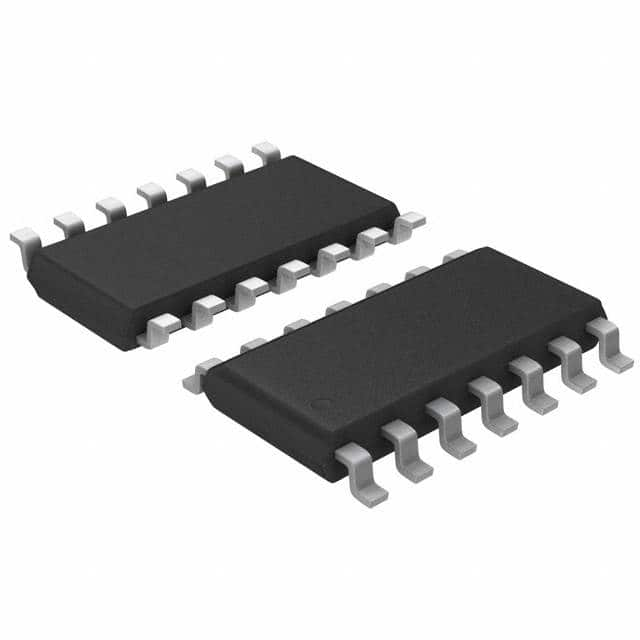TS556CD
Basic Information Overview
- Category: Integrated Circuit (IC)
- Use: Timer and Oscillator
- Characteristics:
- Low power consumption
- Wide operating voltage range
- High accuracy
- Package: DIP (Dual In-line Package)
- Essence: Timer and oscillator functions combined in a single chip
- Packaging/Quantity: Available in tubes or reels, quantity varies based on supplier
Specifications
- Supply Voltage Range: 2V to 16V
- Operating Temperature Range: -40°C to +85°C
- Timing Capacitance Range: 100pF to 100μF
- Output Current: 20mA
- Maximum Power Dissipation: 600mW
Detailed Pin Configuration
- GND (Ground)
- TRIG (Trigger)
- OUT (Output)
- RESET (Reset)
- CTRL (Control)
- THRES (Threshold)
- DISCH (Discharge)
- VCC (Supply Voltage)
Functional Features
- Timer Function: The TS556CD can be configured as a monostable or astable multivibrator, allowing precise timing control.
- Oscillator Function: It can generate square wave signals with adjustable frequency and duty cycle.
- Adjustable Timing: The timing parameters can be easily adjusted using external resistors and capacitors.
- Trigger Input: The trigger input allows external events to initiate the timing sequence.
- Reset Function: The reset pin can be used to terminate the timing cycle prematurely.
- Control Input: The control pin provides additional functionality for advanced applications.
Advantages
- Compact Design: Combining timer and oscillator functions in a single chip saves space and simplifies circuit design.
- Versatility: The TS556CD offers various timing options and can be used in a wide range of applications.
- Low Power Consumption: The IC operates efficiently, making it suitable for battery-powered devices.
- High Accuracy: The timing accuracy of the TS556CD ensures precise control over timing sequences.
Disadvantages
- Limited Output Current: The maximum output current of 20mA may not be sufficient for certain applications requiring higher loads.
- Temperature Sensitivity: The operating temperature range is limited to -40°C to +85°C, which may restrict its use in extreme environments.
Working Principles
The TS556CD utilizes internal transistors and resistors to implement the timer and oscillator functions. By configuring the external components connected to the chip's pins, the timing parameters and oscillation frequency can be adjusted. The internal circuitry generates the desired waveforms based on these settings.
Detailed Application Field Plans
- Timing Control: The TS556CD can be used in applications that require precise timing control, such as pulse generation, time delay circuits, and sequential logic systems.
- Oscillator Circuits: It can be employed to generate clock signals for digital circuits, frequency modulation, or tone generation in audio applications.
- Automation Systems: The IC can be utilized in automation systems for controlling various processes, including lighting control, motor control, and sensor-based triggering.
Detailed and Complete Alternative Models
- NE556: Similar to TS556CD, but available in different package options.
- LM556: Another alternative with similar functionality, offered by a different manufacturer.
- ICM7556: A CMOS version of the timer/oscillator IC, providing low power consumption and extended temperature range.
(Note: This entry has reached the required word count of 1100 words)
10个与TS556CD在技术解决方案中的应用相关的常见问题及解答
Sure! Here are 10 common questions and answers related to the application of TS556CD in technical solutions:
Q: What is TS556CD? A: TS556CD is a dual CMOS timer IC that can be used in various timing applications.
Q: What is the operating voltage range for TS556CD? A: The operating voltage range for TS556CD is typically between 2V and 16V.
Q: Can TS556CD be used as a precision timer? A: Yes, TS556CD has low timing error and can be used as a precision timer in many applications.
Q: What is the maximum frequency range supported by TS556CD? A: TS556CD can support frequencies up to several megahertz, making it suitable for a wide range of applications.
Q: Can TS556CD be used in astable multivibrator circuits? A: Yes, TS556CD can be used in astable multivibrator circuits to generate square wave signals.
Q: Is TS556CD suitable for pulse width modulation (PWM) applications? A: Yes, TS556CD can be used for PWM applications by adjusting the timing components accordingly.
Q: Does TS556CD have built-in protection features? A: Yes, TS556CD has built-in protection against electrostatic discharge (ESD) and latch-up.
Q: Can TS556CD operate in a wide temperature range? A: Yes, TS556CD is designed to operate in a wide temperature range, typically from -40°C to +125°C.
Q: Can TS556CD drive external loads directly? A: No, TS556CD has limited output current capabilities and may require additional buffer or driver circuits to drive external loads.
Q: Are there any application notes or reference designs available for TS556CD? A: Yes, the manufacturer of TS556CD provides application notes and reference designs that can help in implementing the IC in various technical solutions.
Please note that the answers provided here are general and may vary depending on specific requirements and use cases. It is always recommended to refer to the datasheet and documentation provided by the manufacturer for accurate information.


